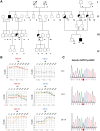A novel missense variant in PRKCB segregates low-frequency hearing loss in an autosomal dominant family with Meniere's disease
- PMID: 27329761
- PMCID: PMC5179939
- DOI: 10.1093/hmg/ddw183
A novel missense variant in PRKCB segregates low-frequency hearing loss in an autosomal dominant family with Meniere's disease
Abstract
Meniere's Disease (MD) is a complex disorder associated with an accumulation of endolymph in the membranous labyrinth in the inner ear. It is characterized by recurrent attacks of spontaneous vertigo associated with sensorineural hearing loss (SNHL) and tinnitus. The SNHL usually starts at low and medium frequencies with a variable progression to high frequencies. We identified a novel missense variant in the PRKCB gene in a Spanish family with MD segregating low-to-middle frequency SNHL. Confocal imaging showed strong PKCB II protein labelling in non-sensory cells, the tectal cells and inner border cells of the rat organ of Corti with a tonotopic expression gradient. The PKCB II signal was more pronounced in the apical turn of the cochlea when compared with the middle and basal turns. It was also much higher in cochlear tissue than in vestibular tissue. Taken together, our findings identify PRKCB gene as a novel candidate gene for familial MD and its expression gradient in supporting cells of the organ of Corti deserves attention, given the role of supporting cells in K+ recycling within the endolymph, and its apical turn location may explain the onset of hearing loss at low frequencies in MD.
© The Author 2016. Published by Oxford University Press. All rights reserved. For permissions, please email: journals.permissions@oup.com.
Figures



References
-
- Corti A. (1851) Recherches sur l’organe de l'ouïe des mammiferes. Limaçon. Z. Wiss. Zool, 3, 106–169.
-
- Lopez-Escamez J.A., Carey J., Chung W.H., Goebel J.A., Magnusson M., Mandala M., Newman-Toker D.E., Strupp M., Suzuki M., Trabalzini F., et al. (2015) Diagnostic criteria for Meniere's disease. J. Vestib. Res., 25, 1–7. - PubMed
-
- Harcourt J., Barraclough K., Bronstein A.M. (2014) Meniere's disease. Bmj., 349, g6544.. - PubMed
Publication types
MeSH terms
Substances
Grants and funding
LinkOut - more resources
Full Text Sources
Other Literature Sources
Medical
Miscellaneous

